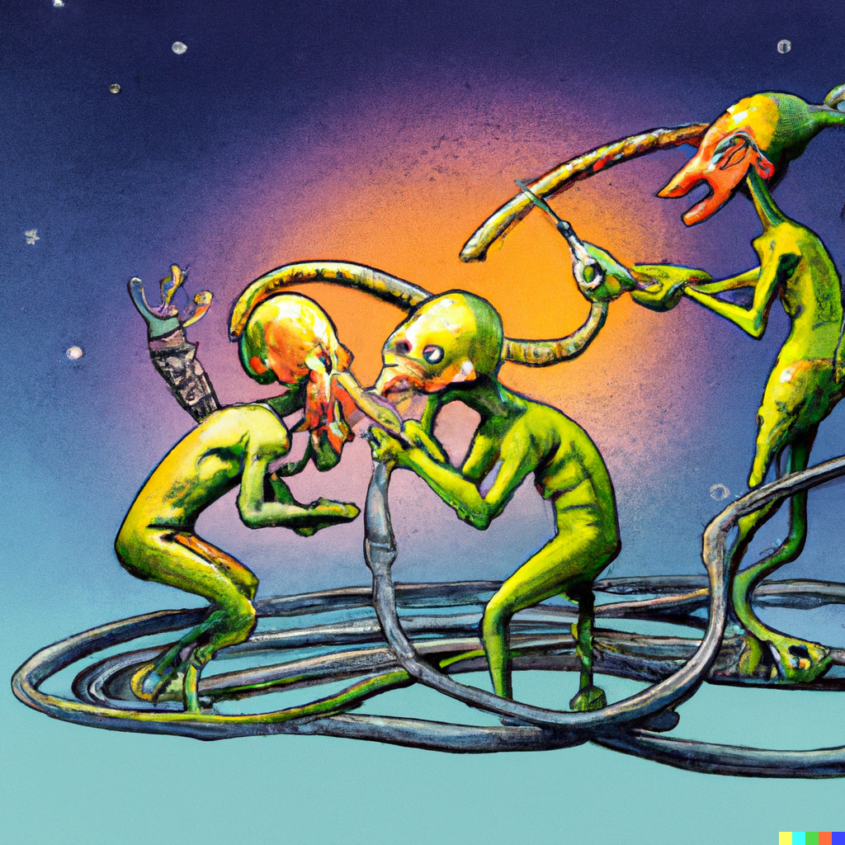
Alongside Sonalux, I’ve been working at Studiocare, an incredible environment made of several audio professionals, musicians and DJs; all music lovers. There are many things I could talk about this amazing place, where sine waves sweep and pink noise radiate in every corner, as well as all other sorts of sound experimentation (the plastic wrapping around crates, the lifting machine that looks like the ‘power loader’ from 1986’s Aliens, etc!). Today I would like to highlight an interesting conversation I had with some colleagues in the service department who are cable specialists since they create hundreds of cables every day. By the way, their biggest dread is the D-sub cable (it looks like a snake with legs). D-sub is the word I constantly hear them yell.
I asked these gentlemen if they think that aliens (more evolved than humans and capable of travelling between planets) would still use cables in their societies. Their answer leaned towards no because more advanced species would have already conquered the world of wireless/cableless transmission. But what about the connections in their spaceships? Would everything there be wireless? Wouldn’t it make sense that some things needed to be connected by cables?
I didn’t know the cable object could elicit such a profound philosophical investigation! If we start looking for analogies, cables are everywhere around us. Our bodies have veins and arteries that carry blood, as well as axons in our nervous system that carry electrical currents. Trees have branches and trunks for nutrition exchange, not to mention the mystical networks of mycelium that reside beneath the earth. What about our roadways, which connect vehicles in the same way electrons go from place to place… I’m thinking now of the timelapse in Hilary Harris’s Organism, or Koyaanisqatsi (I can hear now the bass singing in Philip Glass’s soundtrack).
What if there are limitations in the physics of electromagnetic transmission? How about if we will never manage to lift enough electrical joules around us because of safety concerns? Not to mention the complexity of our electromagnetic spectrum which has already been filled with so many protocols for encoding and decoding data, and still fails when we try to transmit the zero and ones of an HDMI Tx-Rx, which requires antennas and stability to work correctly. How about the latency factor that still prevents musicians from rehearsing with a band online? Will 5G ever be good enough to allow us to do that?
Considering lifting power up in the air, WPF (Wireless Power Transfer) is a field of study that continues to evolve. I recall being very excited some years ago when I read studies regarding WiFi energy harvesting techniques. I thought I could use these methods for some of my sound canvasses, but the power we are talking about here is so low that it can barely power LEDs. Interestingly, a company called Energous has recently received FFC approval for their wireless tech, so it seems that soon we will have 1W transmitters for IoT devices, and that should be a great system for powering low-wattage electronic art, dispensing any batteries and cables (I’m really looking forward to getting my hands on this and have recently emailed the company enquiring about their 1W kit).
Maybe a completely wireless world is something too utopic to imagine: a transparent world where information flows invisibly, where we don’t have wires to trip over, no black lines in the middle of a performance, and no strings attached (literally).
Many times wireless is just a fashion and cables can do a better job. There are many things I prefer to have plugged in my workplace, including my keyboard. It’s absurd that companies like Logitech have their ‘best’ keyboard line reserved to wireless keyboards. If your computer can’t access the Bluetooth, how do you use your computer? How do you access the BIOS if needed? A corded keyboard is essential! I also find it funny that some surround speakers are marketed as “wireless.” Sony, for example, advertises their surround speakers as wireless. They may receive music wirelessly, but each one of them still requires power cords plugged into a power socket for the internal amplifiers, making them NOT wireless.
Nevertheless, as wireless communication evolves, we also have the incredible new USB-C specs that combine data and power (240W is now conceivable with USB-PD). This standard should make our home setup more practical and efficient and its adoption has become a priority study in our Sonalux projects.
To end this article, here are some more images I generated with AI to illustrate aliens making cables.





